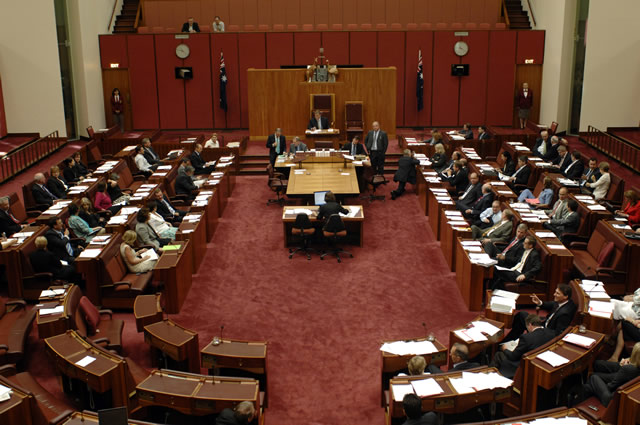
The numbers are in. Well, almost. The AEC has declared the Senate results for Victoria and there are no shocks or surprises left. The composition of the Senate has been determined.
There is a cast of forty shiny newly elected senators who we’ll be utterly sick of the sight of when their terms end on June 30, 2025.
Congratulations voters. Give yourselves a big pat in the back. The freak show is over, the tent has been pulled down and the freaks have been prodded out of their cages. They are now free to roam among us, but at least we won’t have to refer to them in the honorific when we see them shuffling around in the aisles of liquor stores.
It turns out Senate elections are a bit easier to predict now. In the recent past, voters have been shocked and dismayed to find not just people they had never heard of but people representing political parties they had never heard of standing in the Senate, hands on Bibles, awkwardly trying to recite their oaths of office.
We owe this success to Malcolm Turnbull or more properly to the cross-party Joint Standing Committee on Electoral Matters which made a series of recommendations to the Turnbull government. Most were adopted and Senate voting was reformed to end the ugly business of preference harvesting and the rise of micro parties.
The reforms were introduced for the 2016 double dissolution election, but the benefits weren’t felt as the quota for a senator was reduced by half, leading to every weirdo and his or her misshapen dog to park their backsides on a red chair.
In truth, the 2016 double dissolution election was unnecessary given a House of Reps/half-Senate election was due within months. The results were a disaster for Prime Minister Turnbull and the Coalition who not only lost 14 seats to Labor but created a quagmire in the Senate.
Despite the reforms the freak show rolled on. And in many ways, sealed Malcolm Turnbull’s fate.
It is only now the benefit of the reforms is being realised. And some interesting results have been thrown up, enough to keep psephologists drooling over preference flows for above and below the line voting and whatever else takes up their time. For us normal people, it means for now and the next three years, the numbers are Coalition 35, Labor 26, Greens nine, PHON two, Centre Alliance two, and one apiece to Australian Conservatives and the network of one, Jacqui Lambie.
Even before the election, there was a strong sense the Coalition would increase its numbers on the floor of the Upper House by a minimum of four, almost regardless of the outcome in the Lower House. Overall, the Coalition has increased by five, four short of a majority. The Coalition did better than the polls indicated, sure, but they were always going to be the primary beneficiaries of the voting reforms and the extinction of the minor parties due to their high primary vote.
As a talking point, the prospect of a majority in both houses is a distinct possibility. Under the voting system scrapped after the 2013 election, this was virtually impossible. It would require a big shift in voting intention in the Senate and would be more likely to be enjoyed by the Coalition than Labor but it can now happen.
The most unpredictable element was Labor’s historically bad performance in Queensland, returning to the new parliament with just one newly elected senator. The LNP has three, while former s.44 (i) casualties, Larissa Waters from the Greens, and Malcolm Roberts from PHON are back in the red room.
This is more than a mirror of the results in Queensland where Labor won just six of the 30 seats up for grabs north of the Tweed for a net loss of two. It is arguably a worse result and reflects how big the task is for Albanese and Labor to regain the confidence of Queenslanders.
Ultimately, the numbers are easy to understand. The Coalition has 35 Senate seats. Labor and the Greens have 26 and nine respectively. Even stevens. The cross benchers will hold sway over the government’s legislation as before but with the disappearance of four minor parties from the Senate floor, the government’s job has been made a lot easier.
In the last few days, there has been a lot of talk about Cory Bernardi returning to the Coalition fold. It may happen but it won’t make a lot of difference to the horse trading that will go on to pass the government’s legislation. It would simply be neater. The facts are the government will need the support of the Centre Alliance and/or Jacqui Lambie to get its legislation through, regardless of where Bernardi sits in the chamber, presuming that PHON is on board with the government which is not going to always be the case.
However, the salient point is the horse trading that will take place after July 1 will not be of the interminable type where a government has to deal with multiple minor parties with divergent interests.
It should also reduce the awful politicking that is associated with the introduction of legislation. It’s not a rubber stamp on the government’s legislative agenda either. It is a pretty good balance and should lead to a cleaner, smoother parliament.
In short, the fine Australian tradition of sending barking mad politicians to Canberra continues but it’s been toned down a touch and that’s a good thing.
This column was first published in The Australian on 19 June 2019.
